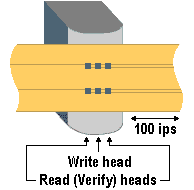The quarter-inch-tape cartridge (QIC) was first introduced in 1972 by the 3M company as a means to store data from telecommunications and data acquisition applications. As time passed, the comparative inexpensive QIC drive became an accepted data storage system – especially for standalone PCs.
QIC cartridges look much like audio tape cassettes, with two reels inside, one with tape and the other for take-up. The reels are driven by a belt built into the cartridge. A metal rod, known as a capstan, projects from the drive motor and pinches the tape against a rubber drive wheel.
The QIC format employs a linear (or longitudinal) recording technique in which data is written to parallel tracks which run along the length of the tape. It is the number of tracks that is the principle determinant of capacity. The cartridges come in two varieties, DC600 cartridge and DC2000 minicartridge, the latter being the more popular. The encoding method used is either MFM (Modified Frequency Modulation) or RLL (Run Length Limited) – similar to the way in which data is encoded on a hard drive.
When a backup is commenced, directory information from the file allocation table is loaded into a memory buffer in the system’s RAM, along with the appropriate files. Both sets of data are sent to the tape drive controller, each file being prefaced by a header containing the directory information. If the controller has built-in error correction, an error correction code (ECC) is appended to the data in the controller. Otherwise, the software adds the code before sending the data to the controller.
The controller contains its own buffer. Once the backup data containing the ECC is in this buffer, the backup software is free to load more data into system memory. The drive’s controller then sends the data as required to the tape drive mechanism.
QIC tape uses an erase head – capable of erasing the full width of a tape in a single pass – and a linear read/write head similar to those found in domestic cassette recorders. Typically this comprises a single write head flanked on either side by a read head. This allows the tape drive to verify data just written when the tape is running in either direction. If the data just written is verified by the read head, the buffer is flushed out and new data is acquired from the system memory. If errors are found, the segment is rewritten on the next length of tape.

In recording mode the tape moves past the stationary read/write heads at 100-125in per second. With a standard drive and format, the head reads or writes data in straight lines, one track at a time. Additional read/write heads can be added to improve performance. The 800 KBps achieved by two heads could be doubled to 1600 KBps by four heads. In some environments where high performance and capacity are required, as many as 36 read/write heads can be stacked up at one time.
The first track written is just below the middle of the tape. When the tape reaches one of its ends, the direction reverses and the head goes to the next outside track. In this way the tracks on the top half of the tape – half the total number of tracks for the particular QIC format – are recorded in one direction and the tracks recorded on the bottom half of the tape in the other direction.
Each track is made up of blocks of 512 or 1,024 bytes, of which there are 32 in a segment. Eight of the 32 blocks contain error correction code, and each block contains a cyclic redundancy check (CRC) at the end for further error correction. Generally, a special directory track, or the beginning of track 0, contains a complete directory of backed-up files.
As the QIC standards of the time failed to keep up with the storage media explosion of the mid-1990s, the QIC cartridge underwent an evolution which increased capacities by both lengthening and widening the tape. The Sony-inspired move to a wider format tape was a particularly development.
The following table shows the native capacities for the most commonly used formats which can, of course, be doubled with data compression:
| Standard | Tracks | 0.25in width | Longer tape | 0.315in width |
|---|---|---|---|---|
| QIC-80 | 28/36 | from 80MB | to 400MB | to 500MB |
| QIC-3010 | 40/50 | 340MB | – | 420MB |
| QIC-3020 | 40/50 | 670MB | – | 840MB |
| QIC-3080 | 60/72 | 1.2GB | 1.6GB | 2GB |
| QIC-3095 | 72 | – | 4GB | 2GB |
One of the drawbacks with QIC is incompatibility. The format has suffered from an overabundance of standards over the years – there are more than 120 currently – and not all QIC drives are compatible with all standards. The early QIC formats contain between 20 and 50 parallel tracks. TheQIC-wide and Travan formats generally use 72 tracks or more – the current maximum is 144. QIC-3220-MC defines a Travan mini-cartridge standard using 108 tracks and providing a native storage capacity of 10MB and Tandberg has a high-end format called multichannel linear recording, offering a capacity of 13GB. The latter adds servo tracks to the tape, which allows for higher recording density and faster tape speeds, to give increased capacity and sustained transfer rates approaching hard disk speeds. The servo is used to keep the head precisely aligned with the tape while it records on multiple tracks at the same time.
The Travan specification is an attempt by the tape industry, particularly the 3M conglomerate, to rationalise the situation by offering a number of high capacity formats which offer a degree of backwards compatibility with earlier QIC standards.